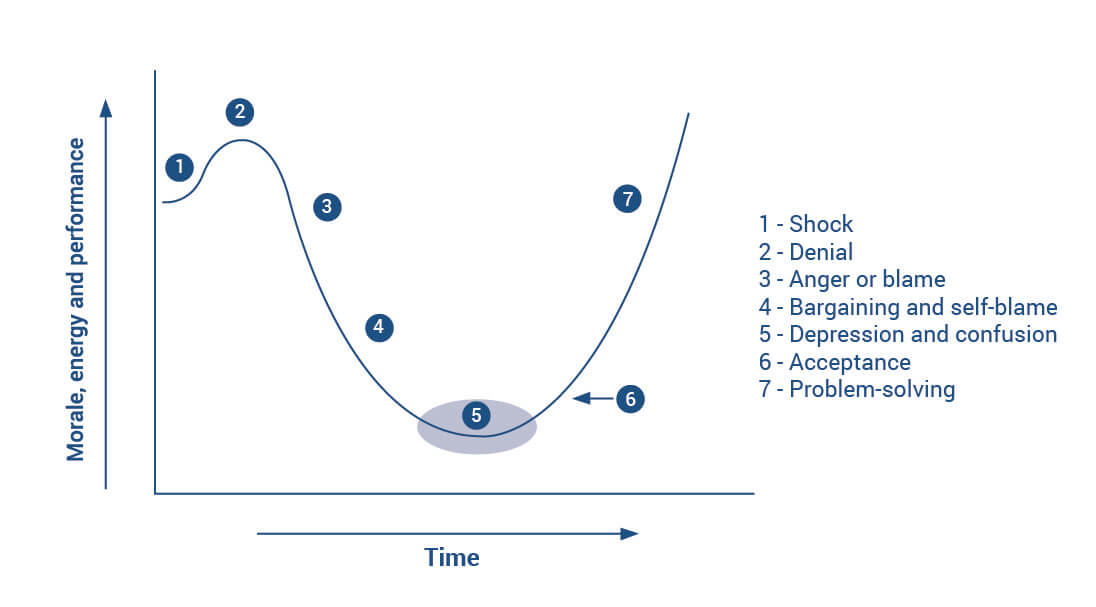27 March 2018 | Updated on 28 June 2018
The change curve…where do your team sit?
Does anyone really enjoy change? You’d probably be hard-pressed to find someone who would embrace it with open arms. Yet, in our working lives, it is inevitable. So, how do you manage a team of peo...
Does anyone really enjoy change? You’d probably be hard-pressed to find someone who would embrace it with open arms. Yet, in our working lives, it is inevitable.
So, how do you manage a team of people who are undergoing change? How do you anticipate and plan for behaviours that will impact a change, whilst still managing to get the best out of your project?
One way to begin is by understanding how individuals react to and process change. The change curve (found in The Effective Change Manager’s Handbook) is a well-established model that illustrates the seven stages of how people typically react to change.
How does it help?
Firstly, it gives an insight into how your teams might react: it’s a predictor. It helps you get ahead by planning for all the stuff that might, but hasn’t, yet happened.
The change curve prompts you to check the mood of your team and helps to interpret their actions — even your most treasured team members may experience stress during times of change. But if you understand where they are on the curve, you will know when using a reward strategy would be wasted… and when it is most likely to pay off.
It helps you to be a successful leader too, because you can use it to guide your own management style. If your team are “exploring” different routines don’t drive too hard for “integration” yet — the erratic behaviour that you are seeing is likely to be part of their journey. Let them work it through for themselves before you start to celebrate unity and conformity — it’s a legitimate and ultimately predictable response to change.
In essence, when applied to business situations, the change curve can help you to respond appropriately to individuals in your team by helping you to recognise characteristic behavioural patterns.
The first stage describes the initial shock that comes with change, where the usual reaction is to resist and deny what is happening. Often, people will find that their mood and productivity are increased in this phase as they try to continue as normal.
This leads into the next stage where individuals can become angry about their circumstances. Often, people begin to blame others for the situation, and the attitude of ‘it’s not fair’ and ‘it’s all the management’s fault’ may become a rather hostile issue to deal with as a project manager who’s responsible for delivering a change project.
Contrary to this, individuals will then characteristically move into a phase of self-blame. Once it becomes evident that the change is not going away due to any admitted fault by an external party, they may find themselves wondering if there is anything they can do themselves to stop the change. During this period, team members may attempt bargaining as a way out; for instance, taking on more work or working longer hours.
As the curve works its way down, we come to the lowest stage of the process – depression and confusion. Until now, all behaviour has demonstrated a drive to hold onto the way that things were, rather than embracing the new. Now, however, with the realisation that all efforts to achieve this are failing, morale and work performance can plummet.
This entire process could happen across a matter of hours, or it could stretch to days, weeks or even months. However, in order to move forward to the point where your team are accepting the change and working through ways to adapt to this, it is important to empathise with, listen to and communicate with your team so that you can work together towards your end-goal.
Our Change Management™ course shows you more about how the behaviours in this model can affect your team dynamic, as well as dictating the best way for you to respond that is both sensitive to the individual, and beneficial to your project. The course also covers everything you need to become qualified in change management.
Have a look at our Change Management course options here.
